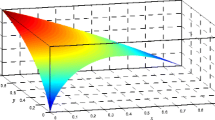Abstract
While analyzing statistical data we face with a problem of modeling uncertainty. One among well justified models is based on belief structures that allow us to describe imprecision and conflict in information. We use this model for analyzing contradiction in weather forecasts. For this aim we build several measures of contradiction based on the introduced imprecision index and the disjunctive aggregation rule for interval belief structures. We use these characteristics for analyzing weather forecasts.
Access this chapter
Tax calculation will be finalised at checkout
Purchases are for personal use only
Similar content being viewed by others
Notes
- 1.
Smets considers also in [17] interval belief structures, but they are not finitely defined.
References
Bronevich, A.G., Klir, G.J.: Measures of uncertainty for imprecise probabilities: an axiomatic approach. Int. J. Approximate Reasoning 51, 365–390 (2010)
Bronevich, A.G., Lepskiy, A.E.: Imprecision indices: axiomatic, properties and applications. Int. J. Gen. Syst. 44(7–8), 812–832 (2015)
Cuzzolin, F.: \(L_p\)-consonant approximations of belief functions. IEEE Trans. Fuzzy Syst. 22, 420–436 (2014)
Daniel, M.: Belief functions: a revision of plausibility conflict and pignistic conflict. In: Liu, W., Subrahmanian, V.S., Wijsen, J. (eds.) SUM 2013. Lecture Notes in Computer Science, vol. 8078, pp. 190–203. Springer, Heidelberg (2013)
Dubois, D., Prade, H.: A note on measures of specificity for fuzzy sets. Int. J. Gen. Syst. 10(4), 279–283 (1985)
Dubois, D., Prade, H.: A set-theoretic view of belief functions: logical operations and approximations by fuzzy sets. Int. J. Gen. Syst. 12(3), 193–226 (1986)
Dubois, D., Prade, H.: Consonant approximations of belief functions. Int. J. Approximate Reasoning 4, 419–449 (1990)
Dubois, D., Prade, H.: On the combination of evidence in various mathematical frameworks. In: Flamm, J., Luisi, T. (eds.) Reliability Data Collection and Analysis, pp. 213–241. ECSC, EEC, EAFC, Brussels (1992)
Jousselme, A.-L., Maupin, P.: Distances in evidence theory: comprehensive survey and generalizations. Int. J. Approximate Reasoning 5, 118–145 (2012)
Kantorovich, L.V.: On mass moving. Dokl. Akad. Nauk USSR 37(7–8), 227–229 (1942)
Klir, G.J.: Uncertainty and Information: Foundations of Generalized Information Theory. Wiley-Interscience, Hoboken (2006)
Lepskiy, A.E.: About relation between the measure of conflict and decreasing of ignorance in theory of evidence. In: Proceedings of 8th Conference of the European Society for Fuzzy Logic and Technology (EUSFLAT 2013), pp. 355–362. Atlantis Press, Amsterdam, Beijing, Paris (2013)
Liu, W.: Analysing the degree of conflict among belief functions. Artif. Intell. 170, 909–924 (2006)
Rubner, Y., Tomasi, C., Guibas, L.J.: The Earth mover’s distance as a metric for image retrieval. Int. J. Comput. Vis. 40(2), 99–121 (2000)
Shafer, G.: A Mathematical Theory of Evidence. Princeton University Press, Princeton (1976)
Smets, P.: The combination of evidence in the transferable belief model. IEEE Trans. Pattern Anal. Mach. Intell. 12, 447–458 (1990)
Smets, P.: Belief functions on real numbers. Int. J. Approximate Reasoning 40(3), 181–223 (2005)
Author information
Authors and Affiliations
Corresponding author
Editor information
Editors and Affiliations
Rights and permissions
Copyright information
© 2018 Springer International Publishing AG
About this paper
Cite this paper
Bronevich, A.G., Spiridenkova, N.S. (2018). Measuring Uncertainty for Interval Belief Structures and its Application for Analyzing Weather Forecasts. In: Kacprzyk, J., Szmidt, E., Zadrożny, S., Atanassov, K., Krawczak, M. (eds) Advances in Fuzzy Logic and Technology 2017. EUSFLAT IWIFSGN 2017 2017. Advances in Intelligent Systems and Computing, vol 641. Springer, Cham. https://doi.org/10.1007/978-3-319-66830-7_25
Download citation
DOI: https://doi.org/10.1007/978-3-319-66830-7_25
Published:
Publisher Name: Springer, Cham
Print ISBN: 978-3-319-66829-1
Online ISBN: 978-3-319-66830-7
eBook Packages: EngineeringEngineering (R0)




